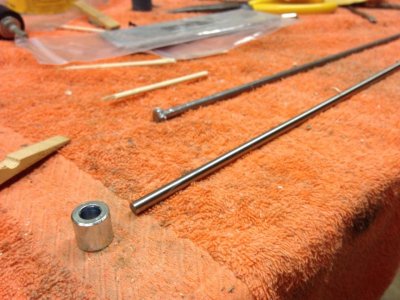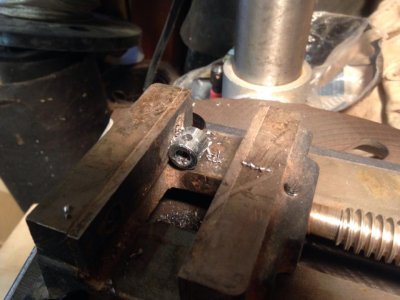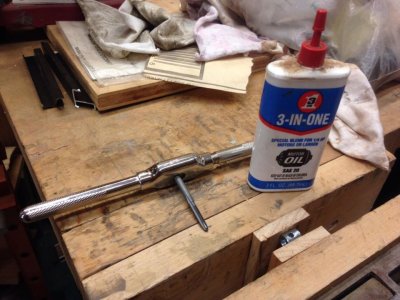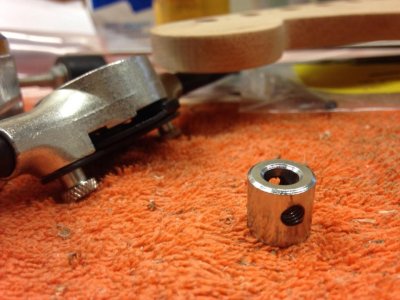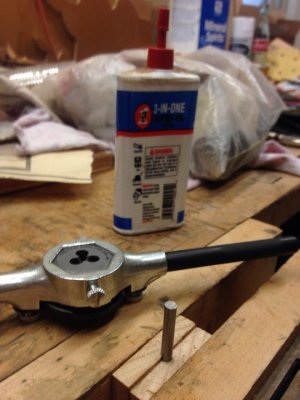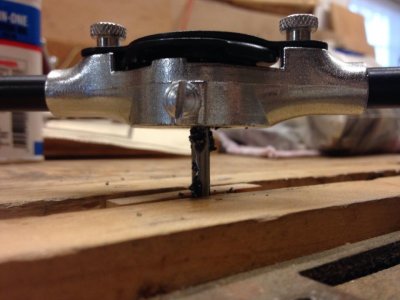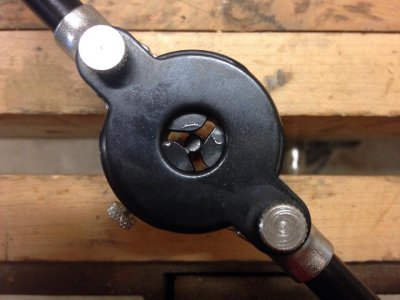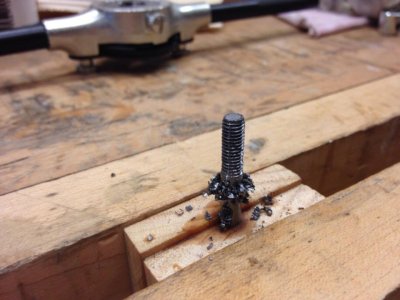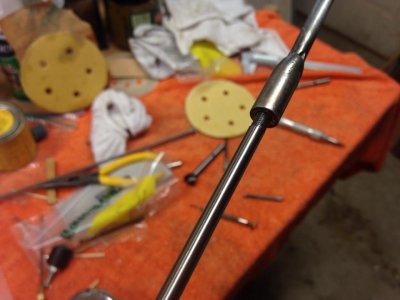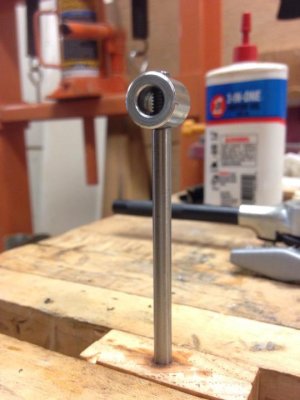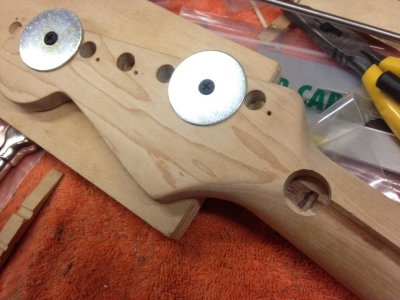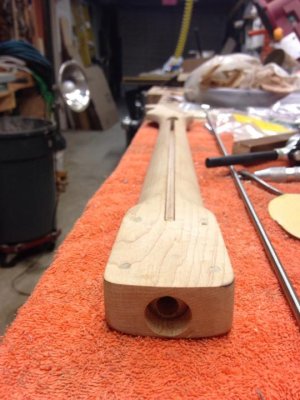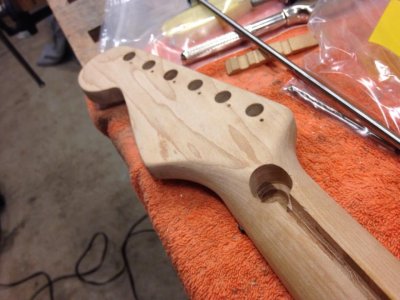ItsaBass
New member
I haven't made a thread about it yet, but I'm doing a major spiffing up of my first guitar, a modified '85 MIJ Strat. I installed a vintage-correct Kahler from an '80's Jackson, and made some other changes that I'll get into when it is all done.
I am also stripping an refinishing the neck. It has had a thin matte finish, possibly an oil finish, the entire time I've owned it (since '94). But the guitar was water damaged a few years back, and the finish was screwed up. So I have stripped it and I am preparing to refinish it (tedious work sanding in between the frets with progressively finer grits).
But what I didn't know is that the water also apparently rusted the truss rod nut to the rod! I went to tweak it a little bit tonight in order to do some fret work before the re-spray, and it was stiff. I didn't even think I turned it hard, but whatever I did caused the dreaded "pop" that every guitar tech fears, followed by a tensionless spinning of the rod in either direction. I was sure I had busted the rod. I tried and tried for 30 minutes to get the adjustment nut off using a variety of methods, but I could not.
Hoping that the break was near the threads, I routed out a little around the adjustment nut, so that I could get a pliers on the nut and pull, then maybe be able to use the StewMac truss repair kit. No dice. The break was obviously farther up the neck. I found plenty of truss repair threads online, but none on a one-piece maple neck. So, I said **** it. I have nothing left to lose here, but potentially a lot to learn. I started hacking into it with my router-bit-equipped Craftsman Dremel equivalent.
I had no idea where the break was, so I just decided that I would do a little exploratory surgery and remove the entire skunk stripe. I routed freehand at first, getting the bulk of the meat out just so I could figure out what was up. I got to the end of the stripe, but still no break. The rod just spun when I turned the screwdriver. So I went farther, looking for the anchor. It turns out it was pretty high up, almost exactly under the nut. I had to search around a bit for it, but finally located it. I apologize to the wood that was unnecessarily removed, but I will plug you up later, and nobody will ever see, since it's on the back. Besides, this is a learning experience for me, so now I know to "explore" in smaller increments when I am routing up that high, not half an inch lengths at a time.
Then I realized that, ****, there was no break at all. This guitar just used a straight-knurled round anchor (dumb design), and it was spinning in its slot! I always assumed the anchors on these necks were rectangular, to avoid this very situation. Is this just a MIJ thing? Here it is after the freehand butcher job:

At any rate, the rod had to come out. I went back over the channel with a guide on both sides, putting the rotary tool in its router attachment and riding the aluminum rail directly (not ideal, but what else could I do). The bit actually fared okay after all that metal-on-metal contact, though at over 10 years old, it is probably due to be replaced anyhow, so I will be getting a new one soon. Those scraps of plastic on the table are what the rod was sheathed in. The plastic sheath keeps glue off of the rod when the skunk stripe is glued in in the factory, as well as giving it a smoother surface to ride against when it is being adjusted.

Finally, after a bit more detailed chiseling/X-Acto-knifing, clearing out more material from around the anchor, and many failed attempts, I was able to grab the anchor hard with a pliers and pull the rod out.


It ain't pretty, but it will look fine later. I'm gonna obviously just take a forstner bit and make a neat round hole out of that sloppy mess. For an anchor, I'll probably use a threaded metal cylinder, and install a maple plug over it. I'm gonna go for something different on the skunk stripe by using a strip of maple or ebony instead of the usual walnut. Herringbone might be pretty bit-chin' too, but I probably won't do it. The entire rest of the guitar is nothing but cream and black (all hardware, screws, and even the nut are black), so the ebony might fit in (and I already have a strip of it that would work). I do think maple would look really nice, though.
Allparts sell a vintage style truss rod for nine bucks, and I think I'm just gonna go with that, slightly modding it to take a cylindrical anchor.
Well, this is an unexpected hurdle in the middle of this project that is already fairly large, but oh well. I think the neck is gonna be salvageable, so I can keep the guitar's full sentimentality intact. And with maybe $20 or $30 in parts needed, it is actually quite an inexpensive repair (not even taking up much time, really). Most importantly, I've learned a lot from it.
I am also stripping an refinishing the neck. It has had a thin matte finish, possibly an oil finish, the entire time I've owned it (since '94). But the guitar was water damaged a few years back, and the finish was screwed up. So I have stripped it and I am preparing to refinish it (tedious work sanding in between the frets with progressively finer grits).
But what I didn't know is that the water also apparently rusted the truss rod nut to the rod! I went to tweak it a little bit tonight in order to do some fret work before the re-spray, and it was stiff. I didn't even think I turned it hard, but whatever I did caused the dreaded "pop" that every guitar tech fears, followed by a tensionless spinning of the rod in either direction. I was sure I had busted the rod. I tried and tried for 30 minutes to get the adjustment nut off using a variety of methods, but I could not.
Hoping that the break was near the threads, I routed out a little around the adjustment nut, so that I could get a pliers on the nut and pull, then maybe be able to use the StewMac truss repair kit. No dice. The break was obviously farther up the neck. I found plenty of truss repair threads online, but none on a one-piece maple neck. So, I said **** it. I have nothing left to lose here, but potentially a lot to learn. I started hacking into it with my router-bit-equipped Craftsman Dremel equivalent.
I had no idea where the break was, so I just decided that I would do a little exploratory surgery and remove the entire skunk stripe. I routed freehand at first, getting the bulk of the meat out just so I could figure out what was up. I got to the end of the stripe, but still no break. The rod just spun when I turned the screwdriver. So I went farther, looking for the anchor. It turns out it was pretty high up, almost exactly under the nut. I had to search around a bit for it, but finally located it. I apologize to the wood that was unnecessarily removed, but I will plug you up later, and nobody will ever see, since it's on the back. Besides, this is a learning experience for me, so now I know to "explore" in smaller increments when I am routing up that high, not half an inch lengths at a time.
Then I realized that, ****, there was no break at all. This guitar just used a straight-knurled round anchor (dumb design), and it was spinning in its slot! I always assumed the anchors on these necks were rectangular, to avoid this very situation. Is this just a MIJ thing? Here it is after the freehand butcher job:

At any rate, the rod had to come out. I went back over the channel with a guide on both sides, putting the rotary tool in its router attachment and riding the aluminum rail directly (not ideal, but what else could I do). The bit actually fared okay after all that metal-on-metal contact, though at over 10 years old, it is probably due to be replaced anyhow, so I will be getting a new one soon. Those scraps of plastic on the table are what the rod was sheathed in. The plastic sheath keeps glue off of the rod when the skunk stripe is glued in in the factory, as well as giving it a smoother surface to ride against when it is being adjusted.

Finally, after a bit more detailed chiseling/X-Acto-knifing, clearing out more material from around the anchor, and many failed attempts, I was able to grab the anchor hard with a pliers and pull the rod out.


It ain't pretty, but it will look fine later. I'm gonna obviously just take a forstner bit and make a neat round hole out of that sloppy mess. For an anchor, I'll probably use a threaded metal cylinder, and install a maple plug over it. I'm gonna go for something different on the skunk stripe by using a strip of maple or ebony instead of the usual walnut. Herringbone might be pretty bit-chin' too, but I probably won't do it. The entire rest of the guitar is nothing but cream and black (all hardware, screws, and even the nut are black), so the ebony might fit in (and I already have a strip of it that would work). I do think maple would look really nice, though.
Allparts sell a vintage style truss rod for nine bucks, and I think I'm just gonna go with that, slightly modding it to take a cylindrical anchor.
Well, this is an unexpected hurdle in the middle of this project that is already fairly large, but oh well. I think the neck is gonna be salvageable, so I can keep the guitar's full sentimentality intact. And with maybe $20 or $30 in parts needed, it is actually quite an inexpensive repair (not even taking up much time, really). Most importantly, I've learned a lot from it.
Last edited:

